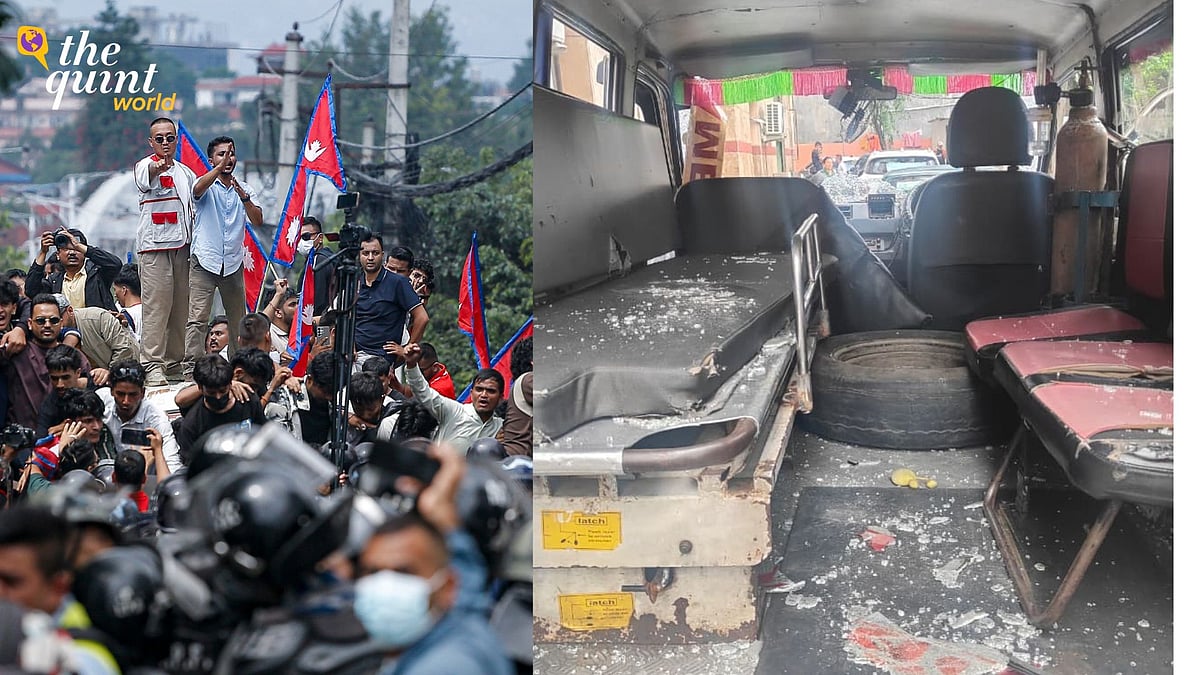'Drivers Hit, Ambulances Vandalised': Nepal's Unsung Heroes on Gen Z Protests
Several ambulances were vandalised during the Nepal protests after rumours spread that they were hiding politicians.

advertisement
As Gen Z protests engulfed Kathmandu and other parts of Nepal in September 2025, police fired tear gas, rubber bullets, and live rounds at young protesters enraged with entrenched corruption and the government ban on social media. Protesters, some of them still in school uniform, allegedly tossed stones in return.
As the dust settles, Nepal's ambulance workers have come forward to talk about how they moved through chaos, carrying wounded protesters and security personnel on board, often in danger. However, they allege, that they came under attacks by both sides.
'Ambulance Drivers Targeted Despite Their Impartiality'
"At least 12 ambulances were vandalised across the country, including nine in the capital," Nawaraj Lamichhane, chair of the Joint Ambulance Drivers Association Nepal (JADAN), told The Quint.
A damaged ambulance in Kathmandu during the Gen Z protests.
(Photo Courtesy: Pratik Ghimire)
During the peak of the recent violence in Nepal, an ambulance was torched outside the Parliament building in Kathmandu as rioters "erroneously" believed they were transporting politicians. At least one video circulated on social media showed a police personnel purportedly shooting at an ambulance on which an injured protester was trying to board.
Ganesh Sapkota, treasurer at JADAN, whose ambulance was also partly damaged during the protests, told The Quint that he and four other ambulances were on standby on 8 September in Kathmandu.
Yet, they were not spared. He alleged to The Quint that despite "urging the protesters not to attack the ambulances", their vehicles were vandalised.
Abiral Khadka, another ambulance driver, was transporting a critically ill patient, who had been airlifted to Tribhuvan International Airport in Kathmandu, when he and his ambulance came under attack.
(Photo Courtesy: Pratik Ghimire)
Khadka added that only when the protesters cracked open the ambulance, and saw that the patient inside was on oxygen support, did they stop the attack.
(Photo Courtesy: Pratik Ghimire)
His damaged ambulance was repaired the next day by Su-Swasthya Nepal, the NGO that owned it. On the second day of the Gen Z protests, this reporter was at Kathmandu's Nepal Police Hospital where the ambulances bearing signs of the vandalisation were brought.
'No Help From Police'
In Rupandehi district, ambulance driver Balbir Khamcha was transporting a patient on oxygen support. On the second night of the protest, at around 11 pm, his ambulance was attacked by a mob of 15-odd people at Sainamaina Municipality.
“They was drunk, and attacked us without listening to a word we had to say,” he said. “One of the protesters even slapped me."
Khamcha said that during the attack, the patient’s oxygen cylinder fell off. They rushed the patient to a nearby polyclinic, and he was later referred to the Provincial Hospital in Butwal. The patient died on the way.
Khamcha told The Quint that he immediately called the police, but they did not turn up. When he called them again after around 30 minutes, the phone had been switched off.
The Quint reached out to Binod Ghimire, Deputy Inspector General of Nepal Police, who said he's not authorised to speak on any matter related to the Gen Z protests.
According to multiple news reports, several personnel had fled from police stations for their own security. A number of police stations were also torched by protesters.
(Photo Courtesy: Pratik Ghimire)
A Neglected Workforce
According to JADAN, an ambulance driver’s monthly salary of 10,000-12,000 Nepali rupees is very low considering their work hours and risk exposure. They also get 10 percent of the ambulance income, but it's still not enough.
A 2020 concept paper on Nepal's emergency medical services points out to the country's “neglect model” with most ambulances lacking trained staff or basic equipment. In a study at Patan Hospital in Lalitpur, only 9.9 percent of emergency patients were brought in by ambulance; 53.6 percent were brought in by taxi; and the rest by private cars, buses or motorbikes. Government hospitals, voluntary agencies, and private hospitals operate unregulated ambulance services.
At the same time, attacks on ambulances are nothing new in Nepal. It was reported by the International Committee of the Red Cross that during demonstrations in 2015, stones were hurled at a Red Cross ambulance in Siraha district, leading to four of them sustaining damages.
In 2021, the Nepal government introduced the Ambulance Directive 2078, allowing only the government and hospitals to operated ambulances. The directive is yet to be enforced, with bodies such as JADAN urging the government to amend the rule, arguing that the country will face an ambulance crisis if it is enforced.
“Even now, we have fewer ambulances and drivers than what is needed. Let's forget emergency situations like natural disasters, protests, and epidemics like COVID-19; we can't even operate during normal situations if the directive comes into effect," Sapkota lamented.
(Pratik Ghimire is a journalist based in Kathmandu, Nepal.)